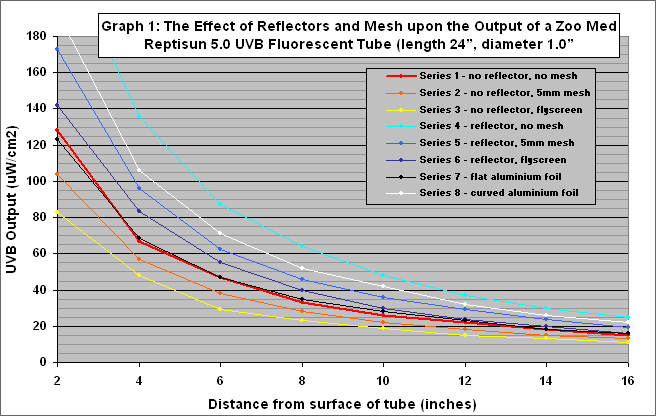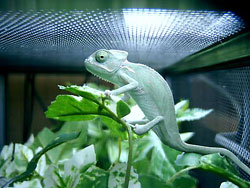|
The
Mesh Test Experiments
Method
Two
types of mesh were used in the experiments:
- 5mm
galvanised mesh
- Black
fly screen mesh
Three
types of reflectors were used:
- A
commercially produced aluminium reflector
- A
home-made reflector made of several layers of flat aluminium
foil
- A
home-made reflector, made in the same way, bent into a
curve to fit behind the tube
A full
set of tests using the mesh and reflectors was conducted
on each of four 24" fluorescent tubes, one each of
the following:
- Zoo
Med Reptisun 5.0
- Arcadia
5.0 D3 Reptile
- ExoTerra
Repti Glo 8.0
- ExoTerra
Repti Glo 5.0
For
each set of tests, the tube on test was set up at the back
of an empty vivarium, and allowed to warm up for a minimum
of 10 minutes, until a constant output was reached.
Series
of readings were then taken with the tube alone, or with
one of the two types of mesh placed directly in front of
it, with or without one of the reflectors. The different
combinations for each series are given in the Key (below)
Readings
were taken at 2-inch intervals, at distances of 2 - 16 inches
from the surface of the tube, for each series.
The
results for the set of tests conducted with a Zoo Med Reptisun
5.0 tube as the source of UVB, are given below. The results
using the other three tubes, despite their differing output,
were directly comparable in terms of the percentage reduction
of effective output caused by the mesh, and the percentage
increase in effective output produced by the reflectors.
Results

Discussion
If 5mm
zinc plated mesh is placed in front of the tube, a 15-20%
reduction in output is seen. (Compare Series 1 with Series
2).
25-35%
losses occur with fly screen of the type often used for
chameleon vivaria (Series 3).
To obtain
the same UVB exposure, the reptile will need to be considerably
closer to the tube if it is behind either type of barrier.
Conversely, for species requiring low UVB, the mesh may
be used to deliberately reduce the levels received.
However,
these losses may be compensated for, by affixing a reflector
behind the tube. This, as we have seen, typically increases
the effective output by up to 100% and so even placing flyscreen
in front will not reduce the UVB level to below that of
a tube with no reflector fitted. (Compare Series 6 with
Series 1).
The
greatest effective increase in output is seen with the commercially
available reflector (Series 4). However, a home-made reflector,
simply made by folding layers of ordinary aluminium foil
proved very effective (Series 8).
When
a flat sheet of aluminium foil was placed behind the light,
little increase in output was recorded (Series 7). However,
separate tests have shown that this does slightly increase
the overall amount of UV available in the vivarium. The
light from behind the tube, which is reflected back into
the vivarium, is directed into the vivarium at an angle,
and hence is not recorded by the meter placed directly in
line with the tube.
The
full details of this set of experiments form part of an
article on Lighting for Chameleons by Rob Lane as published
on www.UKChameleons.co.uk.
Direct link to article (opens in new window): http://www.martinsreptiles.co.uk/ukchams/uvlightingresearch.htm
Download full set of results for
these tests: (pdf file - 165KB):
http://www.martinsreptiles.co.uk/ukchams/intro_uvlighting_tests.pdf
|


















 For
species requiring lower levels of UV light, the reduction
in UVB caused by mesh may be useful. Species needing high
UVB, though, will need to bask closer to a UVB source if
there is mesh between the lamp and the reptile. Use of a
reflector behind the tube may compensate for the reduction,
however.
For
species requiring lower levels of UV light, the reduction
in UVB caused by mesh may be useful. Species needing high
UVB, though, will need to bask closer to a UVB source if
there is mesh between the lamp and the reptile. Use of a
reflector behind the tube may compensate for the reduction,
however.